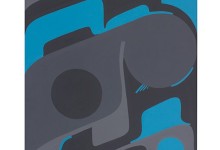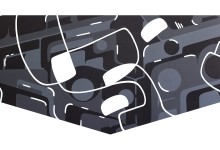Opening reception: March 9th from 3-5pm
Text by Michael Rattray
Subversive forms of data transmission operate in cloud-like structures and facilitate nodes of network activity. These produce the dissident codes of 21st century meme culture, which maneuver a wide spectrum and are categorized by the metadata hashtag. The tags are shorthand talking points, specifically targeting specialized markets of dissemination. In a forum of engagement as vast as contemporary social media networks, the tag has become a way to quickly identify with a greater discussion, or generalization. A question of artistic praxis for the 21st century is the adaptation of this new form of codification and communication. What is lost and what can be gained? Sonny Assu reacts to the above through work that critiques the generalizations necessary for a far-reaching and global structure of network access, dictated by an in-the-know quest for individualization and personalization.
The idrum series sets in binary opposite two forms of musical structure that have consequences for the way in which the individual may be defined. The drum, a powerful instrument of social organization, keeps time and may control a greater social structure. Indeed, the drum acts as a rally, a way in which to syncopate a group or annunciate presence. In contrast, the personal audio device reduces public awareness and renders the user as operating under a cloak of secrecy. All that is apparent about it is its sign-function, the general concept, while the content is personal, specific and unknown. In a room where hundreds dance and no sound is heard the silence might be deafening. Yet, in that space individual alterity would supersede the group logic of freedom defined through complete egoism: a milieu would present itself and it would be classified, not by individuality, but an object of status. In this way, two forms of status are presented within the work that offers critical commentary on the role of the object in the dissemination and communication of individuality.
The question of objectified status and the power of codification is a current in Assu’s oeuvre. In the Chilkat series, an abstraction flattens this question and places the burden of proof upon the spectator to codify themselves through their own assumptions. For as much as the tag, object, or status symbol can signify something direct, it can also function in radical and unissued ways that defy known classification systems. The power inherent to the object d’art is the way in which its status is never completely defined. It, like many of the things we use to label individuality, resists any singular attempt to limit its potential. In this way, these objects of data transmission remain kinetic.






